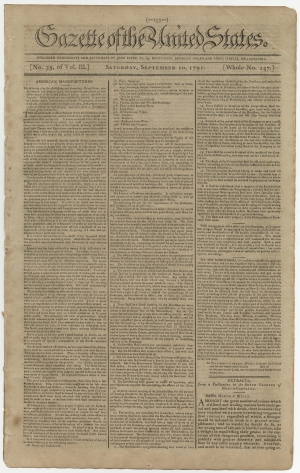|
The Prospectus for Hamilton’s “Society for Establishing Useful Manufactures” |
Click to enlarge:

Select an image:
Currently offered only as part of the Alexander Hamilton Collection: The Story of the Revolution & Founding.
In contrast to the agrarian view of many Virginia founding fathers, New Yorker Alexander Hamilton saw an industrial future for the United States. After nearly two years of study and with the aid of Assistant Secretary Tench Coxe, Secretary of the Treasury Hamilton compiled his famed Report on Manufactures at the request of Congress. With the Society for Establishing Useful Manufactures, Coxe and Hamilton advocated creating the nation’s first public-private partnership to develop the area around the Great Falls of the Passaic River, using the cataract for power.
[ALEXANDER HAMILTON].
Gazette of the United States, September 10, 1791. Philadelphia, Pennsylvania: John Fenno. 4 pp., 10 x 16 in. The prospectus is printed on the front page in three columns.
Inventory #30019
PRICE ON REQUEST
Excerpt
“The establishment of Manufactures in the United States, when maturely considered, will be found to be of the highest importance to their prosperity. It seems an almost self-evident proposition, that communities which can most completely supply their own wants, are in a state of the highest political perfection. And both Theory and Experience conspire to prove that a nation (unless from a very peculiar coincidence of circumstances) cannot possess much active wealth but as the result of extensive manufactures.
“While also it is manifest. that the interest of the community is deeply concerned in the progress of this species of industry, there is as little room to doubt that the interest of individuals may equally be promoted by the pursuit of it.” (p1/c1)
“It is conceived that there would be a moral certainty of success in manufactories of the following articles:
1st. Paper and Pasteboard.
2d. Paper Hangings
3d. Sail Cloth, and other coarse Linen Cloths, such as Sheetings, Shirtings, Diaper, Oznaburghs &c.
4th. The printing of Cottons and Linens; and as incident to this, but on a smaller scale, the manufacturing of the article to be printed.
5th. Womens Shoes of all kinds.
6th. Thread, Cotton and Worsted Stockings.
7th. Pottery and Earthen Ware
8th. Chip Hats.
9th. Ribbands and Tapes.
10th. Carpets.
11th. Blankets.
12th. Brass and Iron Wire.
13th. Thread and Fringes.” (pg. 1/c1-2)
Historical Background
The Society for Establishing Useful Manufactures (S.U.M.) was a public-private partnership to industrialize the area around the Great Falls of the Passaic River. By utilizing the falls’ water power, Hamilton envisioned a planned industrial community that would promote his industrial vision for the United States.
Although no manuscript of the prospectus of the Society in Hamilton’s handwriting has been found, scholars have generally attributed it to him.[1]
On November 22, 1791, New Jersey Governor William Paterson signed the act incorporating the S.U.M.[2] To encourage its development, the state exempted S.U.M. from property taxes for a decade. Washington, D.C. designer Pierre L’Enfant had grand designs for the races and sluiceways to harness the waterpower, but he was soon replaced by the more pragmatic Peter Colt. The society founded the town of Paterson (named after the state’s governor) as one of the first planned industrial centers in the United States. After a shaky start, cotton manufacturing took off in the late 1790s, followed by steel and locomotive manufacturing in the mid-nineteenth century. In the 1880s, Paterson was the center of American silk production. The venture presaged future public-private partnerships.
Additional Content
This issue also contains a report on Joseph Brant (1743-1807), the famous Mohawk military and political leader (p3/c1-2); a portion of the new constitution of Poland (p4/c1-2); and other national, international, and local Philadelphia news and advertisements, including one offering grants of land to those who would settle in Louisiana (p4/c2).
Gazette of the United States (1789-1793) was a semiweekly Federalist newspaper first published in New York City by John Fenno (1751-1798). It is often considered the most significant political newspaper of the late eighteenth century.In 1790, it followed the government to its temporary capital in Philadelphia. This newspaper was often the first to print early Acts of Congress and Presidential Pronouncements, and it circulated to major cities where other Federalist newspapers copied freely from it. Among its pseudonymous contributors were Alexander Hamilton and John Adams. It continued under a variety of titles as a daily newspaper in Philadelphia from 1793 to 1818. After John Fenno’s death in the 1798 yellow fever epidemic, his son John Ward Fenno continued the newspaper until 1800, when he sold it.